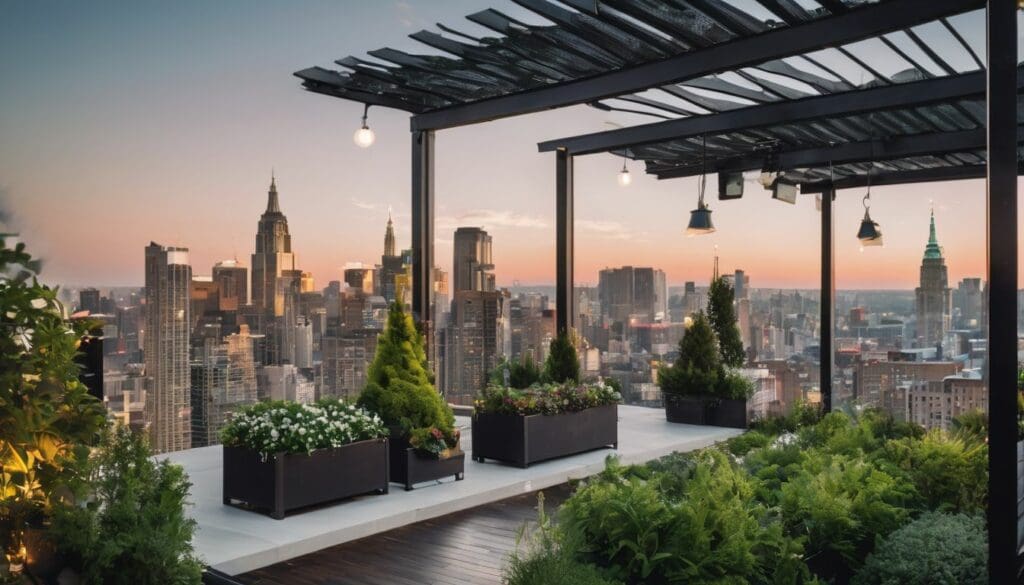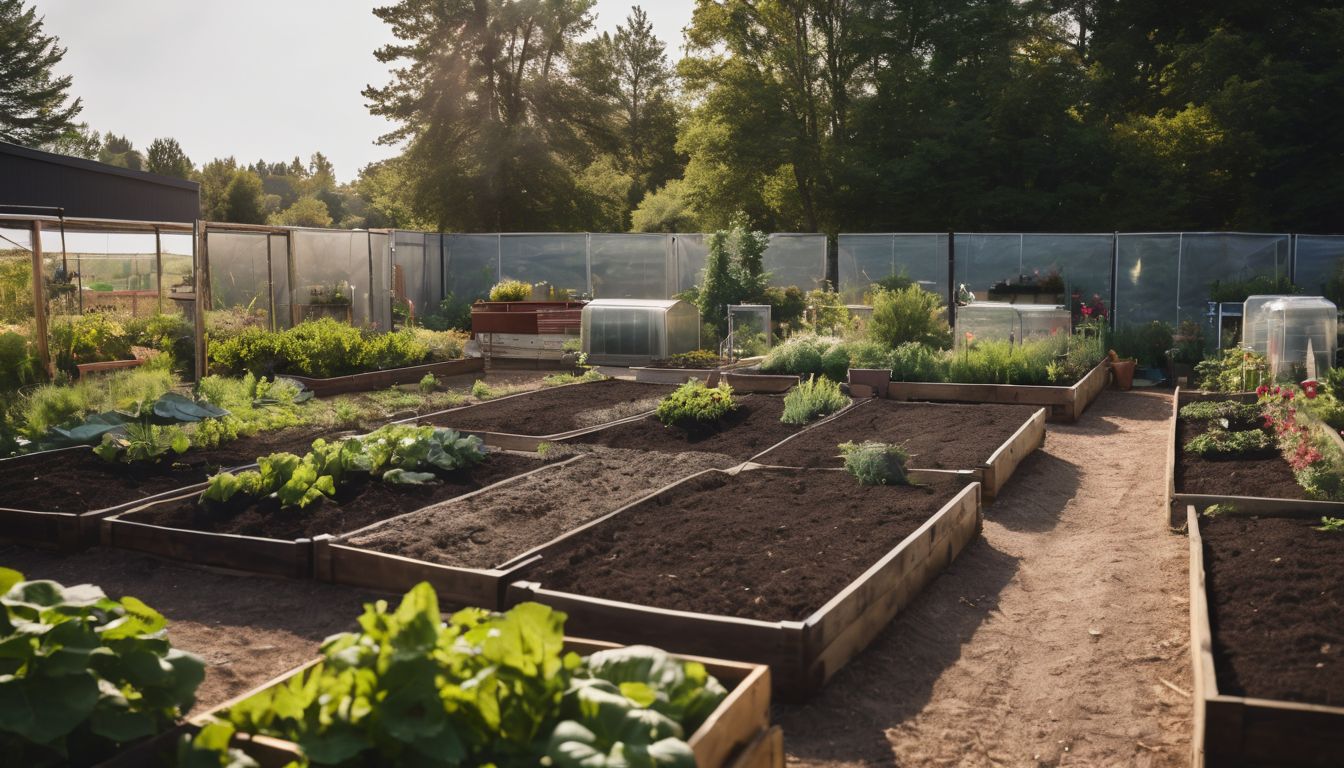Urban living often has us pining for a splash of greenery amid the stark steel and concrete that dominate our cityscapes. We’ve all experienced that longing for a bit of the natural world in our fast-paced urban lives—a sentiment we’re truly familiar with.
With over half of humanity now calling urban areas home, cultivating welcoming pockets of green isn’t merely desirable; it’s essential to our collective health and happiness. This article promises to be your companion in nurturing verdant oases within the metropolitan bustle.
Together, let’s sow the seeds for flourishing city retreats!
Key Takeaways
- Urban green spaces contribute to better mental health by reducing stress and anxiety, enhancing mood, and fostering social interaction among city residents.
- Physical advantages of urban greenery include reduced blood pressure, boosted immune system, improved air quality, and encourages exercise like walking or cycling.
- Green areas in cities can increase productivity through improved well – being and cognitive function; they also make driving conditions safer by improving visibility and encouraging cautious driving.
- Innovative methods for creating urban green spaces involve transforming vacant lots into community gardens or parks, installing green pavements and rooftops with plants, developing pocket parks or urban food forests, and participating in PARK(ing) Day events.
- Effective planning principles for urban greening include conserving existing green spaces, incorporating them in city plans from the outset, connecting them through landscape ecology practices and involving public participation for sustainability.
Why Green Spaces are Important in Urban Areas
Green spaces in urban areas are crucial for mental and physical wellbeing, as well as increased productivity. They also contribute to safer driving conditions, making them an essential aspect of sustainable urban development.
Mental health benefits
Creating green spaces in urban areas brings a breath of fresh air to our mental well-being. We often overlook how city parks, public gardens, and even small community green spaces can act as natural sanctuaries amidst the concrete jungle.
They offer us places to unwind, reflect, and disconnect from the hectic pace of city life. Engaging with nature in these pockets of tranquility can reduce stress levels, enhance mood, and improve overall happiness.
We understand that incorporating vegetation in cities isn’t just about environmental sustainability; it’s also about nurturing our minds. Regular exposure to urban greenery helps combat feelings of anxiety and depression that are all too common in high-pressure environments.
It encourages social interaction which is crucial for emotional support and builds a sense of community among residents who share these verdant oases. Therefore, investing time and effort into urban landscaping not only enriches our surroundings but profoundly uplifts our mental state.
Physical advantages
Green spaces in urban areas offer numerous physical advantages for city dwellers. Being surrounded by nature reduces stress, lowers blood pressure, and boosts the immune system. Regular exposure to greenery encourages physical activity such as walking, jogging, or cycling, which is beneficial for overall health and wellbeing.
Moreover, green spaces can improve air quality by absorbing pollutants and producing oxygen, creating a healthier environment for urban residents.
In addition to this, spending time in green spaces has been linked to improved sleep patterns and enhanced cognitive function. The presence of natural elements like trees and plants has a calming effect on individuals while also providing shade from the sun’s harmful rays.
Increased productivity
Green spaces in urban areas have been shown to increase productivity among residents. The presence of nature and open green spaces has a positive impact on mental health, reducing stress levels and improving overall well-being.
By providing a space for relaxation and recreation, green areas encourage physical activity, leading to improved focus and cognitive function. Engaging with nature within an urban setting can invigorate the mind and promote creativity, ultimately enhancing productivity in both work and daily life.
Incorporating green infrastructure into urban planning not only contributes to environmental conservation but also fosters a healthier and more productive community. Integrating natural elements into our urban surroundings can significantly uplift the spirit of individuals living within these environments while positively influencing their capacity for productivity.
Safer driving
Green spaces in urban areas contribute to safer driving by reducing the risk of accidents and enhancing road safety. Planting trees along roadsides can provide natural barriers, helping to shield pedestrians from traffic and preventing collisions.
Additionally, greenery helps improve air quality which leads to better visibility for drivers, ultimately creating a safer environment for everyone on the road.
Furthermore, incorporating green spaces into urban planning can lead to calmer traffic conditions as it encourages drivers to slow down and be more cautious in these areas. By integrating nature into our cities, we not only promote environmental conservation but also enhance safety for all road users.
Innovative Ways to Create Green Spaces
Identify and utilise vacant lots or unused spaces, plant pavements and green roofs, develop pocket parks or urban food forests, and participate in PARK(ing) Day. Read more to discover how you can create green spaces in urban areas!
Identify and utilise vacant lots or unused spaces
To create green spaces in urban areas, we can identify and make use of vacant lots or unused spaces. This could involve converting abandoned car parks or neglected plots into community gardens, public open spaces, or pocket parks.
By repurposing these areas for nature in urban settings, we contribute to environmental conservation in cities while promoting urban biodiversity. Urban gardening initiatives can transform derelict locations into vibrant hubs of sustainable activity, supporting the growth of local food sources and enhancing the overall quality of city life.
Furthermore, optimising underutilised spaces for greenery also aligns with the principles of urban sustainability. It promotes a sense of environmental stewardship among city dwellers and helps mitigate some negative impacts associated with high-density living environments.
Planting pavements and green roofs
To create urban green spaces, we can plant pavements and install green roofs in buildings. Green roofs involve planting vegetation on the top of structures, providing ecological benefits while reducing heat absorption and improving air quality.
By implementing these strategies, we enhance urban biodiversity conservation and contribute to sustainable cities. Planting pavements with trees and plants helps to reduce surface runoff, mitigate the urban heat island effect, and create more appealing public spaces for recreation.
Utilising green roofs not only enhances environmental conservation in urban areas but also encourages nature in these settings. These innovative methods promote sustainability by reducing energy consumption through natural insulation, resulting in a positive impact on mental health benefits for city residents as well as increasing urban biodiversity conservation.
Developing pocket parks or urban food forests
One way to bring nature into urban areas is by developing pocket parks or urban food forests. Pocket parks are small green spaces that offer a peaceful escape from the bustling city life, providing a place for relaxation and recreation.
Meanwhile, urban food forests are designed to provide fresh produce for local communities while also enhancing the ecological balance of the area. By creating these green spaces within urban environments, we can improve air quality, promote biodiversity, and foster a sense of community ownership over shared natural resources.
To effectively incorporate pocket parks or urban food forests into our cities, it’s crucial to consider the specific needs and preferences of local residents as well as environmental factors such as soil type and sunlight exposure.
Moreover, establishing partnerships with local authorities and community organisations can help ensure long-term maintenance and sustainability of these green initiatives.
Participate in PARK(ing) Day
Participating in PARK(ing) Day offers a creative and impactful way to create green spaces in urban areas. This annual event encourages community members, artists, and activists to transform metered parking spaces into temporary mini-parks or green spaces for people to enjoy.
By participating in this event, we can raise awareness about the importance of urban greenery while demonstrating how small changes can make a big difference in our environment.
PARK(ing) Day provides an opportunity for us to engage with the community, showcase innovative ideas for utilising urban space, and advocate for more permanent green spaces within our cities.
Planning and Principles for Effective Urban Greening
We need to conserve existing green spaces and incorporate them in urban planning. Connecting green spaces through landscape ecology and ecological urbanism is also crucial for effective urban greening.
Conserve existing green spaces
To preserve existing green spaces in urban areas, we can advocate for the protection and maintenance of parks, gardens, and natural landscapes. It is important to recognise the value that these spaces bring to our communities, including biodiversity, wildlife habitats, and recreational opportunities.
By actively participating in local conservation efforts and raising awareness about the significance of these green areas, we can ensure their preservation for future generations to enjoy nature in urban settings.
Looking after our existing green spaces also involves supporting policies that safeguard these environments from development or degradation. Collaboration with local authorities and community organisations can help establish zoning regulations that protect green areas from being converted into commercial or residential properties.
Incorporate green spaces in urban planning
Urban planning must prioritise the incorporation of green spaces to enhance the livability and sustainability of cities. This involves integrating parks, urban agriculture, and other natural elements into the fabric of urban areas.
By embracing this approach, cities can mitigate environmental impacts, improve air quality, reduce heat island effects, and promote biodiversity within their confines.
Incorporating green spaces in urban planning is essential for creating healthier and more vibrant communities. It enhances residents’ well-being by providing recreational opportunities, fostering a sense of community, and promoting physical activity.
Additionally, these green areas contribute to climate resilience by absorbing rainfall water and reducing flood risks in built-up environments.
Connect green spaces through landscape ecology and ecological urbanism
To connect green spaces through landscape ecology and ecological urbanism, we integrate urban environments with natural systems to create a network of interconnected green areas. By strategically planning and designing these spaces, we can enhance biodiversity and support the migration of wildlife within urban settings.
This approach also promotes sustainable water management and mitigates urban heat island effects, contributing to healthier and more resilient communities.
Incorporating landscape ecology principles into urban planning allows us to design functional green corridors that improve air quality, provide recreational opportunities, and foster a sense of wellbeing among city dwellers.
Utilise legal frameworks and public participation
To effectively implement the principles of landscape ecology and ecological urbanism, it is essential to utilise legal frameworks and foster public participation. By integrating green space requirements into urban planning regulations and zoning ordinances, we can ensure that new developments incorporate adequate green spaces.
Public participation in decision-making processes empowers communities to advocate for the preservation and creation of green spaces within their neighbourhoods. This involvement also fosters a sense of ownership and responsibility, leading to the sustainable maintenance of these areas over time.
In addition to legal frameworks, public engagement initiatives such as community meetings, workshops, and online surveys can provide valuable insights into the specific needs and preferences of local residents regarding urban greening efforts.
Green our buildings
To effectively green our urban areas, we must focus on sustainable building practices. Implementing energy-efficient technologies and designs in construction helps reduce the carbon footprint of buildings.
Installing solar panels, incorporating natural ventilation systems, and using eco-friendly materials are essential for creating environmentally friendly structures. Additionally, promoting the establishment of rooftop gardens and green spaces within buildings can contribute to improving air quality and providing natural habitats for urban wildlife.
Moreover, integrating green design principles into architectural plans not only enhances the aesthetic appeal but also fosters a healthier environment for city dwellers. Utilising renewable energy sources and prioritising energy conservation measures are fundamental aspects of greening our buildings, thus contributing to a more sustainable urban landscape.
Conclusion: The Importance of Effective Planning for Urban Green Spaces
Creating green spaces in urban areas is crucial for our well-being. We must consider mental and physical benefits, along with increased productivity. Safer driving can also result from incorporating more greenery into city landscapes.
Developing innovative ways to create these spaces is essential – by utilising vacant lots or planting pavements, we can make a difference. Embracing the principles of effective planning will help us achieve successful urban greening in the future.
FAQs
1. Why is it important to have green spaces in urban areas?
Green spaces bring nature into busy city life, offering fresh air and peaceful spots for everyone to enjoy.
2. What are the first steps to create a green space in an urban area?
Start by choosing the right spot in your neighbourhood, get permission if needed, and plan out which plants or trees you’ll use to fill the space with nature.
3. Can I involve my community in making an urban park?
Absolutely! Gather local support, share your vision for a new green space and work together as a community to make it happen.
4. Are there any special considerations when maintaining a green space in a city?
Yes, think about how often you’ll need to care for the plants and keep the area clean so that everyone can continue enjoying this piece of urban nature.





